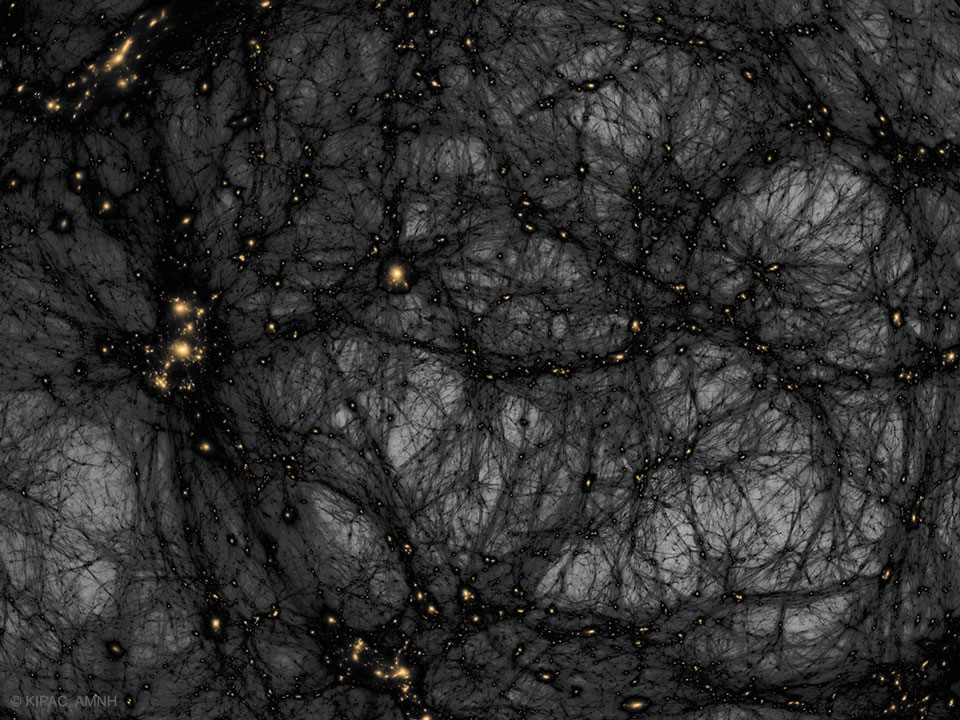Politically accepted term for ether.

Illustration Credit & Copyright: Tom Abel & Ralf Kaehler (KIPAC, SLAC), AMNH
Explanation: Is our universe haunted? It might look that way on this dark matter map. The gravity of unseen dark matter is the leading explanation for why galaxies rotate so fast, why galaxies orbit clusters so fast, why gravitational lenses so strongly deflect light, and why visible matter is distributed as it is both in the local universe and on the cosmic microwave background. The featured image from the American Museum of Natural History's Hayden Planetarium Space Show Dark Universe highlights one example of how pervasive dark matter might haunt our universe. In this frame from a detailed computer simulation, complex filaments of dark matter, shown in black, are strewn about the universe like spider webs, while the relatively rare clumps of familiar baryonic matter are colored orange. These simulations are good statistical matches to astronomical observations. In what is perhaps a scarier turn of events, dark matter — although quite strange and in an unknown form — is no longer thought to be the strangest source of gravity in the universe. That honor now falls to dark energy, a more uniform source of repulsive gravity that seems to now dominate the expansion of the entire universe.
"Dark matter as it is referred to in scientific terms, does not actually refer to being "dark" by a way of low frequency. It actually refers to less density as well as higher light quotient-frequency of matter. It is what should be referred to as "invisible matter" that is indigenous to higher dimensions and of more free flowing-less congealed nature." [Mohsen Paul Sarfarazi, Ph. D.]
In astronomy and cosmology, dark matter is matter that is inferred to exist from gravitational effects on visible matter and background radiation, but is undetectable by emitted or scattered electromagnetic radiation. Its existence was hypothesized to account for discrepancies between measurements of the mass of galaxies, clusters of galaxies and the entire universe made through dynamical and general relativistic means, and measurements based on the mass of the visible "luminous" matter these objects contain: stars and the gas and dust of the interstellar and intergalactic medium. It is probably cold and if so, probably weakly interacting massive particles or many primordial intermediate mass black holes between 30 and 300,000 solar masses, or both. (wikipedia)
SVP asks is gravity the only bonding force in existence? Of course not. Gravity is a symptom or manifestation of syntropy.
Dark matter is an invisible form of matter which, until now, has only revealed itself through its gravitational effects.
Evidence for the existence of this form of matter comes, among other things, from the astrophysical observation of galaxies, which rotate far too rapidly to be held together only by the gravitational pull of the visible matter.
High-precision measurements using the European satellite Planck show that almost 85 percent of the entire mass of the universe consists of dark matter.
All the stars, planets, nebulae and other objects in space that are made of conventional matter account for no more than 15 percent of the mass of the universe.
The unknown form of matter can either consist of comparatively few, but very heavy particles, or of a large number of light ones. Dark Matter Bridge
See Also
Celestial Radiation and Terrestrial Outreach
Connecting Link
Etheric Elements
Gravism
Gravity
Infinite Element
Outreach
Sympathetic Outreach
Syntropy
The Mystery Substance Physics Still Can’t Identify That Makes Up The Majority Of Our Universe
7B.15 - Sympathetic Outreach
